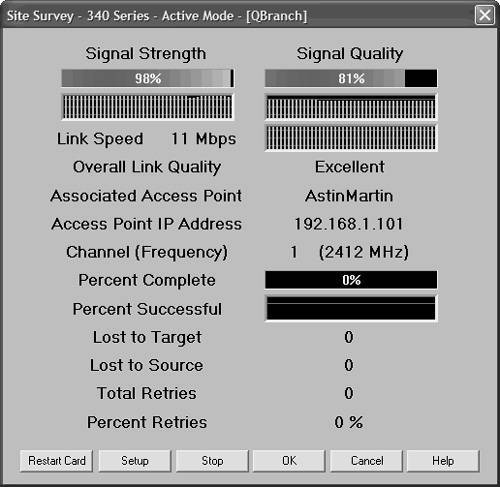Site Survey
| Before you install or configure an AP, you should first conduct a site survey. This exercise shows you where the bestand worstplaces are in your organization for Wi-Fi reception. You use an AP and a client to conduct a site survey. Both the AP and client move around to various, temporary locations in an effort to find ideal placement. Once completed, a thorough site survey tells you:
AP Location for Site SurveyWhen you perform a site survey, try to situate the AP as close to its ultimate location as possible. This helps resolve any problems that might creep up after you mount the AP. In most cases, you should mount APs at ceiling height. In warehouses and other sites with high ceilings, it's best to mount them between 15 and 25 feet. If you mount them at this height, power delivered to the devices must be addressed. Power over Ethernet (PoE) is discussed in greater detail later, but this is an excellent scenario where you should deliver power in via a power injector, line-power enabled devices (such as Catalyst switches), or line-power patch panels (sometimes referred to as a mid-span device). PoE can save a lot of headache and expense. In some environments it might be desirable to keep the AP out of sight. If you opt to place the AP above ceiling panels, you should place antennas below the ceiling for optimal reception. If this is the case, you should purchase an AP that fits for remote antenna capability. Note Check your local fire codes. You might need plenum-rated APs and cabling if they are placed above the ceiling tiles. Performing the SurveyThere are two ways you can perform a site survey: manually or assisted. You typically use the manual method when you first install a WLAN. If you already have a WLAN in place and just want to tweak it, an assisted site survey saves you a lot of shoe leather. Manual Site SurveyThe first way to conduct a site survey is called a manual site survey. This means you pick up a Wi-Fi-enabled laptop, palmtop, or specialized wireless survey device and walk around your site and record data from the temporarily located AP as you go. You should place the AP and antennas where you decide to mount them. However, before you actually mount them, perform the survey, and take your Wi-Fi-enabled device to various client locations within its coverage area. Cisco wireless client adapters (which are examined in greater detail in Chapter 6, "Configuring Clients") include the Cisco Aironet Desktop Utility, which includes a site survey tool component. This tool allows you to view the strength of your AP's signal, the quality of the signal, packet retries, and a host of other data. This tool is shown in Figure 5-1. Figure 5-1. Aironet Desktop Utility Site Survey Tool When you conduct a site survey, be aware of these issues:
Follow these steps when you perform a manual site survey:
It's easy to look at the signal strength meter on your site survey tool and make assumptions based on the strength of the signal you receive. However, you should also be cognizant of the signal-to-noise ratio (SNR). If noise in the band is too high, it can cause reception problemseven if you have a strong signal from the AP. Use the SNR and packet retry count (the number of times packets were retransmitted for successful reception) to get an accurate view of your signal quality. Packet retry count should be below 10 percent in all areas. You should use packet retry in tandem with the SNR reading for a good picture of signal quality. The signal might be strong enough, but because of noise or multipath interference, packets are resent. Without an SNR reading, you cannot tell if packet retries spike because you are out of range, there's too much noise, or the signal is too low. Assisted Site SurveyIf you use the CiscoWorks Wireless LAN Solution Engine (WLSE) or a Wireless LAN Controller, you can perform an assisted site survey. This survey allows you to simulate the optimal radio transmit power and channel selection in an existing WLAN. You can select specific APs in your WLAN, and then generate your results. The assisted site survey allows you to:
The benefit of this test is that it allows you to conduct the site survey without the need to walk all over your office (unless you chose the client walkabout test, of course). It also allows you a certain level of granularity, to pick and choose which devices to test. Although this tool is great for WLANs with existing APs, it's not ideal for preinstallation work. We discuss CiscoWorks WLSE in greater detail in Chapter 10, "CiscoWorks Wireless LAN Solution Engine (WLSE)." Analyzing Your SiteAfter you conduct your site survey, it's time to analyze the data. If you conduct a manual site survey, bring a map along with you and record site data for each location. After you complete the survey, sit down and examine the map. Do you notice poor signal reception in certain areas? What characteristics are at play in that area that might affect signal quality? You should also experiment with different AP and antenna locations to find the best site. Use different maps for different AP placement options, as this helps you keep your data clear and easy to understand. If you encounter interference you simply cannot locate, you might need to use a spectrum analyzer. These devices scan a wide frequency band to locate transmissions. Unfortunately, they are also expensive. You can expect to pay thousands of dollars for one (or you can rent one). On top of the expense, there's a steep learning curve in their configuration, setup, and use. If the purchase of a spectrum analyzer is not in your budget, you might hire a consultant with specialized tools to conduct the site survey. |
EAN: 2147483647
Pages: 126
